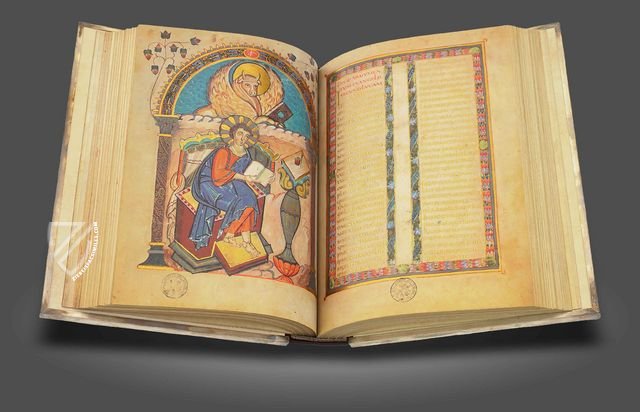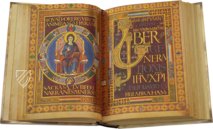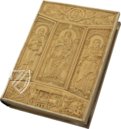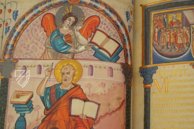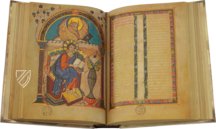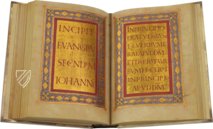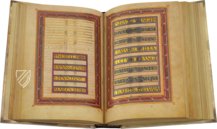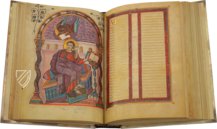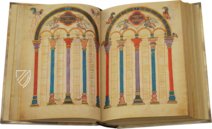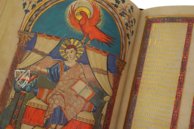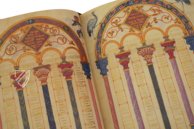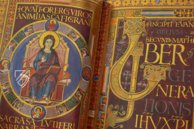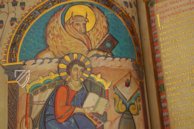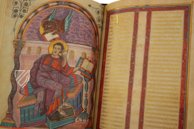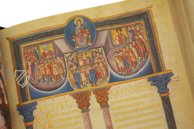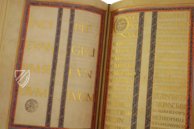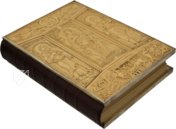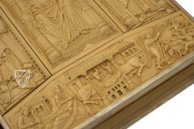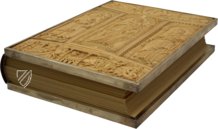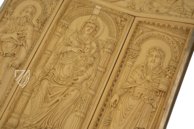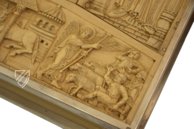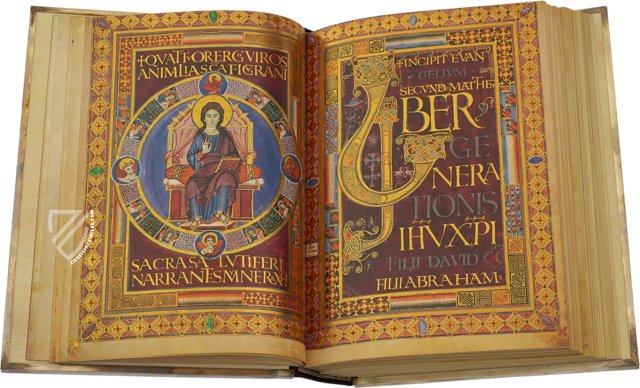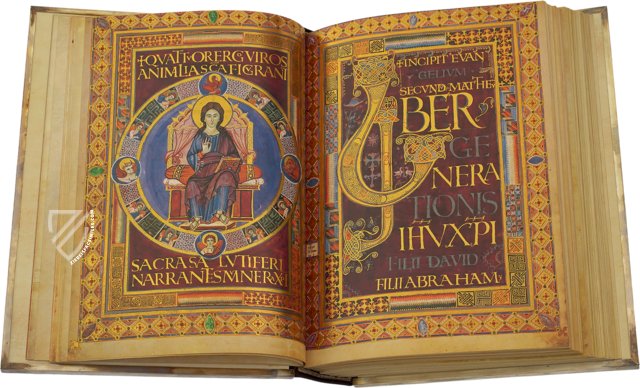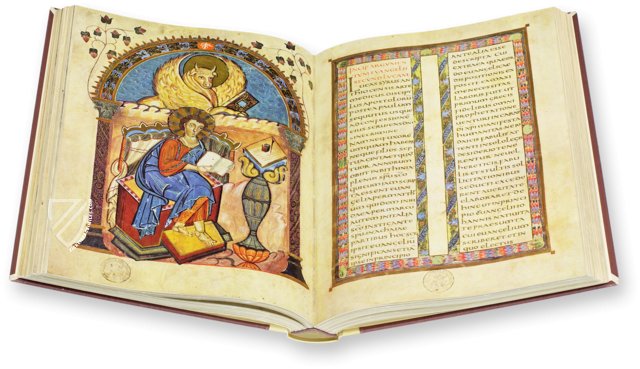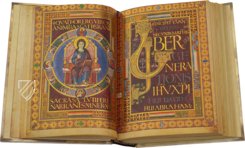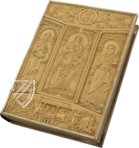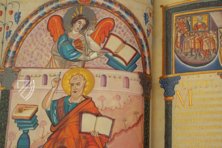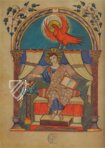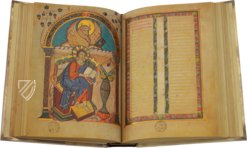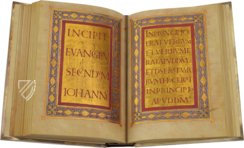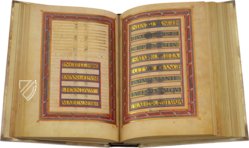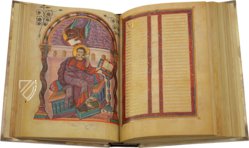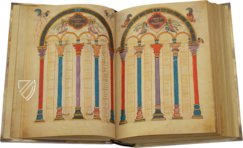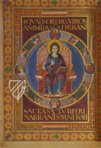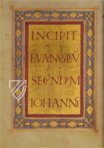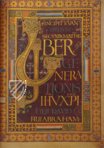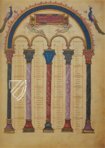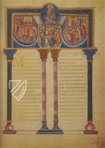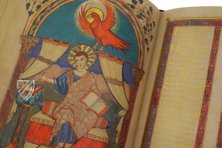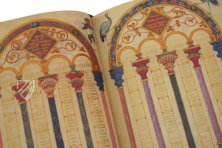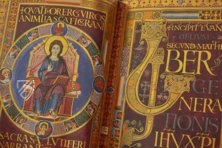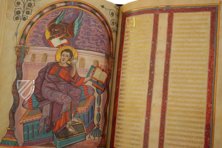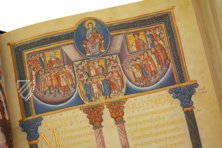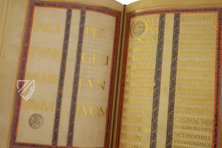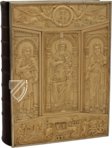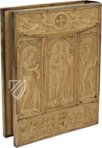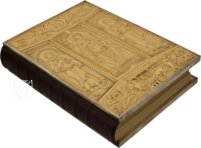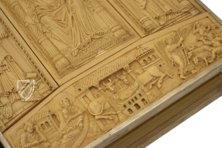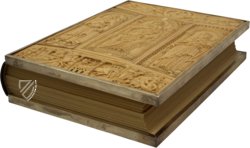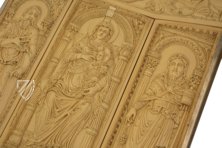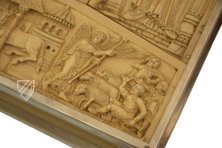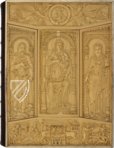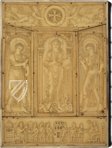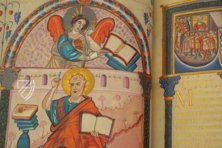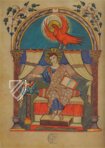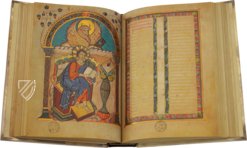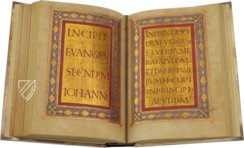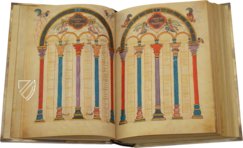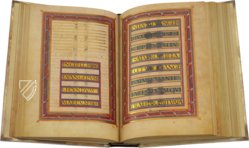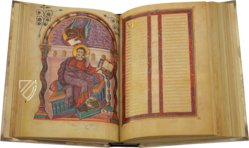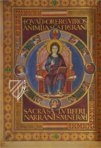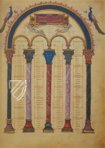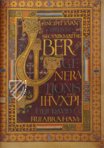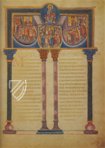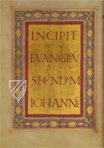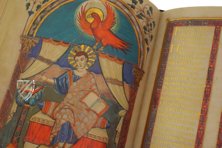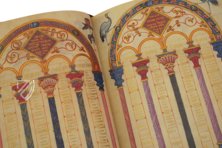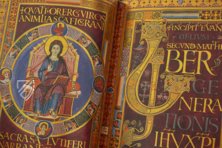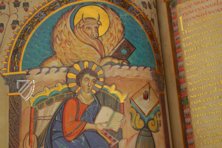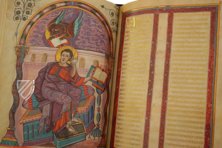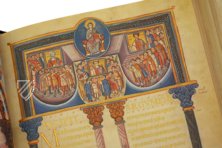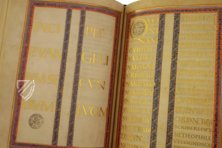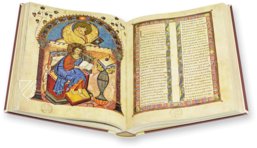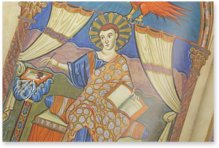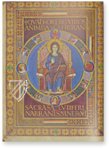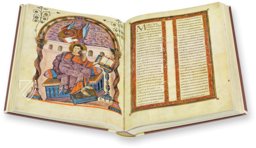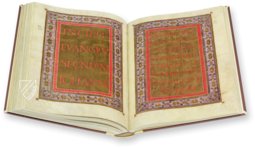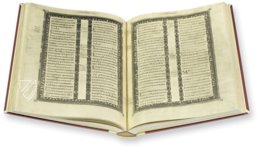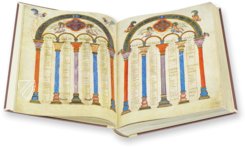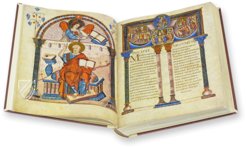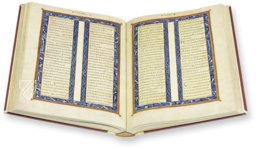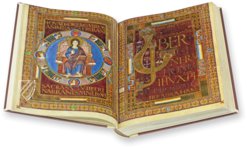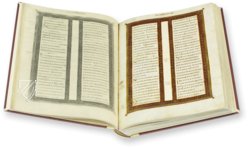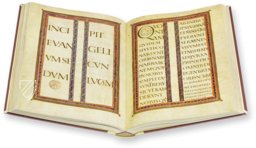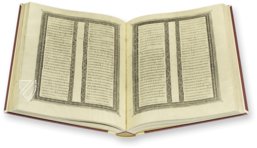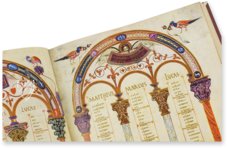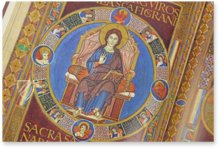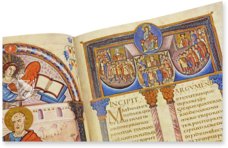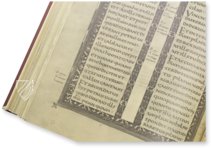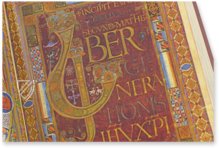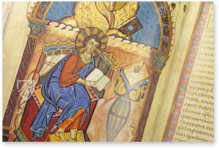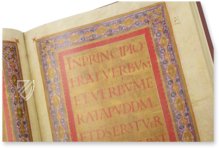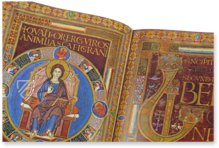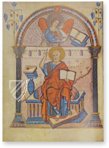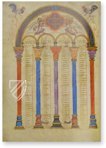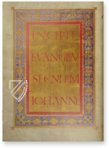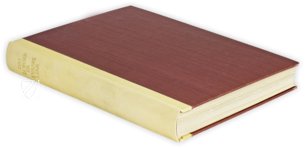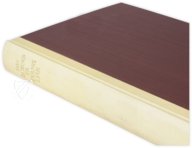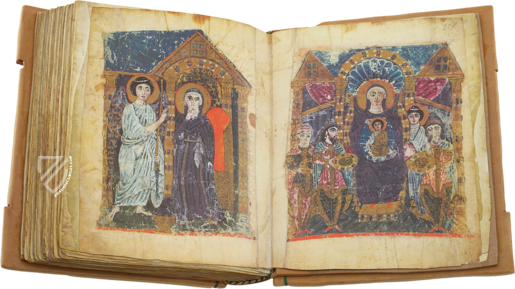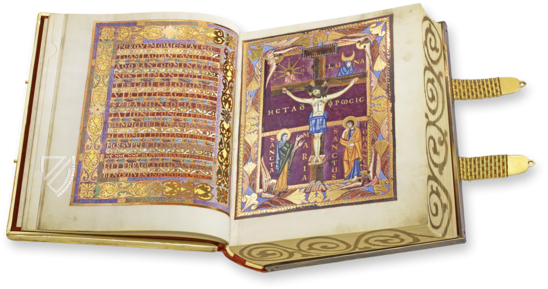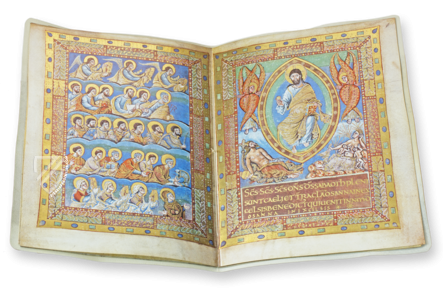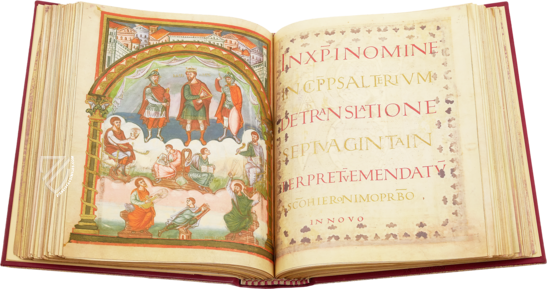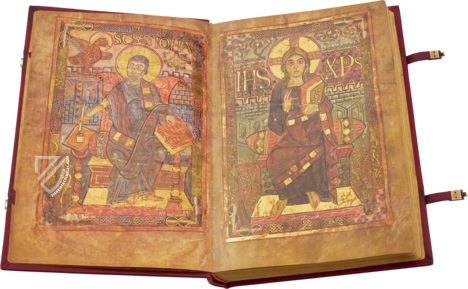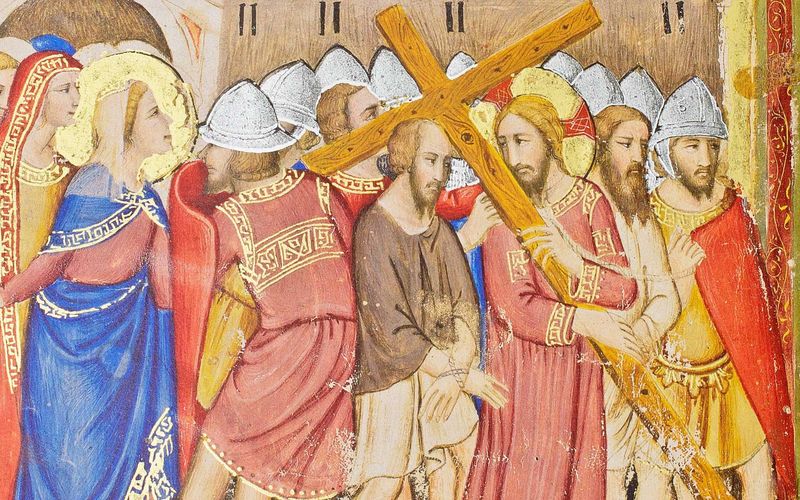Lorsch Gospels
(7,000€ - 10,000€)
The Lorsch Gospels is one of the most important manuscripts of Carolingian book art and, together with its two astonishingly well-preserved ivory covers, each consisting of five parts, represents a true piece of art. The magnificently decorated Gospel manuscript was probably created around 810 in Charlemagne's prestigious court scriptorium and was the model for several other Carolingian manuscripts. The codex is particularly famous for its unmistakable depictions of the Evangelists and the magnificent full-page Maiestas Domini miniature. Moreover, it was decorated all over with gold and even written entirely in gold ink. The immeasurably valuable manuscript looks back on an turbulent and complicated history of ownership, which divided it into several fragments that are brought together in the facsimile edition and allow us to experience this unique work of art as a whole.
Lorsch Gospels (Ivory Binding Edition)
A perfectly-formed artwork that Charlemagne held in his hands originated ca. 810 at the Carolingian Court School in Aachen. It Is the Lorsch Gospels. It is written from front to back in gold ink and is considered to be the youngest of a significant series of splendid manuscripts from the court scriptorium of Charlemagne. The work gets its name from the Lorsch Monastery, in which it was housed from the 9th century until the dissolution of the monastery in 1556. With both of its ivory covers, each consisting of 5 pieces, it represents a downright complete synthesis of the arts. It simultaneously combines all of the stylistic influences that had an impact on Carolingian art. The evangeliary played a decisive role in the development of book art worldwide. It was divided into two parts, which are found today in the Vatican Library and in the branch of the Romanian National Library in Alba Julia. The ivory plates belonging to the book cover are to be found in the Vatican Museum and the Victoria and Albert Museum in London.
Precious Materials
The monumental illuminated manuscript from the Carolingian court school is a work unsurpassed in its rich adornment, which possess inconceivable worth due to its gold script from end-to-end. Each page of the manuscript is adorned by gold frames richly furnished with forms. Splendid, full-page illustrations enchant through their monumentality. Harmonious canon tables, as well as portraits of the Evangelists in the respective forewords, or the splendid beginnings of the Gospel texts exhibit gold and silver in abundance. Precious purple and vivid, luminous colors were employed in the miniatures. The Lorsch Gospels is undoubtedly the most beautiful and precious achievement of the Carolingian court artists, who belonged among the most important representatives of their profession worldwide at that time.
The Journey of the Masterpiece
The precious manuscript probably came to Lorsch from the court of the Kaiser under the Abbot Adalung, where it was recorded in a catalog of the monastic library during the 9th century. In Lorsch, the great royal- and imperial abbey, the manuscript survived the centuries. In the year 1479, it was rebound and was probably already divided into two at that time. After the dissolution of the monastery in 1556, both parts reached the famous **“Bibliotheca Palatina”, the court- and university library of Heidelberg, through Ottheinrich, the bibliophile Prince-Elector of the Palatine, along with many other valuable books from the old monastic library. It was likely gifted to Pope Gregory XV by Duke Maximilian I of Bavaria along with the rest of the collection as a spoil of war in 1623.
A History as Exciting as a Thriller
The second part of the evangeliary, along with the so-called Christ plate, reached the Vatican Library, where it is still diligently kept safe. The Christ plate is displayed in the Vatican Museum. The fate of the first part with its ivory plate depicting the Blessed Mother was disparately adventurous: the Greek scholar Leone Allacci organized and supervised the transportation of the Palatina, escorted by armed knights, from Heidelberg to Rome in 1623. He appears not to have been able to resist the temptation to put aside some books from the rich collection for his own library. Along with numerous other works from the Palatina, he bequeathed the Lorsch Gospels to the Collegium Graecum in Rom, which for its part sold pieces of its library. Since 1711, the splendid evangeliary was considered to be lost. It was probably jealously guarded in a private library in Rome during that time. The ivory plates were separated from the manuscript before 1785. They were a template for a copperplate engraving from the middle of the 18th century – the Carolingian original first resurfaced in 1853 at an auction, reached England, and finally was presented to the Victoria and Albert museum in London where it remains to this day.
Codicology
- Alternative Titles
- Lorscher Evangeliar
Codex Aureus of Lorsch - Size / Format
- 473 pages / 37.0 × 27.0 cm
- Origin
- Germany
- Date
- Ca. 810
- Epochs
- Style
- Genre
- Language
- Script
- Uncial
- Illustrations
- 6 full-page miniatures. Entirely written with gold ink, each page shows colorful frames which are unsurpassed in form and style
- Content
- The Four Gospels written entirely in gold ink
- Patron
- Charlemagne (747–814)
- Previous Owners
- Otto Henry, Elector Palatine (1502–59)
Prince-Elector Maximilian I of Bavaria (1573–1651)
Christoph Bartholomäus Anton Migazzi, Prince-Archbishop of Vienna (1714–1803)
Bishop Ignác Batthyány (1741–98)
Lorsch Gospels
Incipit Page: Gospel of John
The sheer amount of gold leaf dedicated to this masterful incipit page is indicative of how important the opening words of the Gospel of John are to Christian theology. This elegant sentence combines the idea of Jesus’ divinity with the Ancient Greek philosophical tradition of the Logos (word), representing cosmic reason. In principio erat verbum et verbum erat apud Deum et Deus erat verbum “In the beginning was the Word, and the Word was with God, and the Word was God.” (Jn. 1:1)
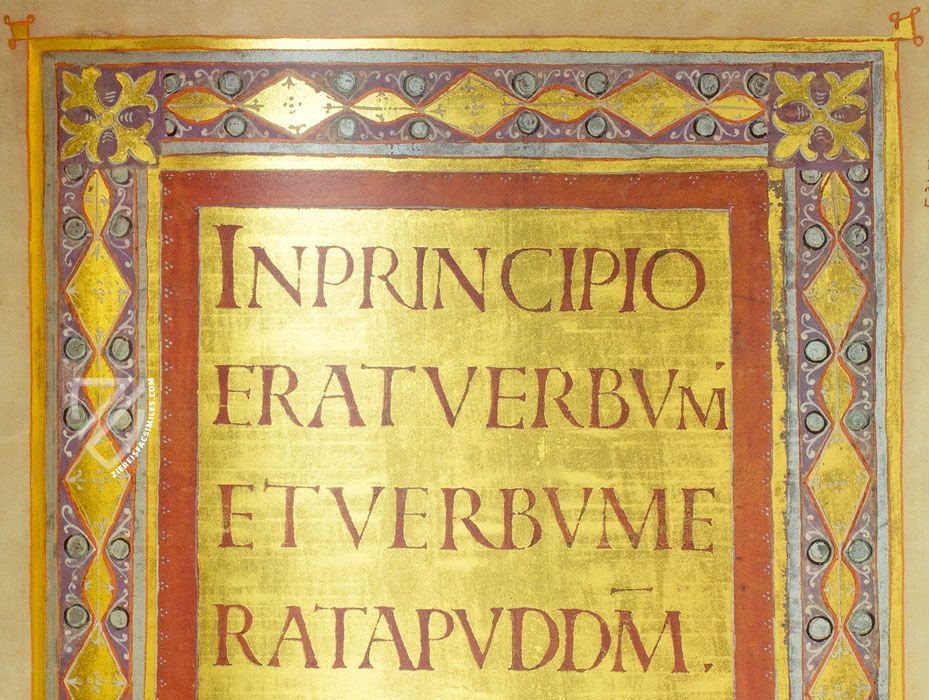
Lorsch Gospels
Christ in Majesty
Also known as the Maiestas Domini, this is one of the most popular images in Western Christian art, which depicts Christ enthroned as ruler of the world. This specimen is dominated by expensive gold leaf and purple dye, indicating that this had to be a commission of the Emperor Charlemagne from his Court School, which is known for its ornate and ostentatious style.
The blend of Byzantine and Insular elements is clear: the figure of Christ is Byzantine with classical robes, flattened, standardized features, and piercing eyes while the intricate patterns framing the image are clearly Hiberno-Saxon. Within the band of the mandorla circling Christ, Insular-style Evangelist symbols appear next to small portraits reminiscent of Late Antique imagery.
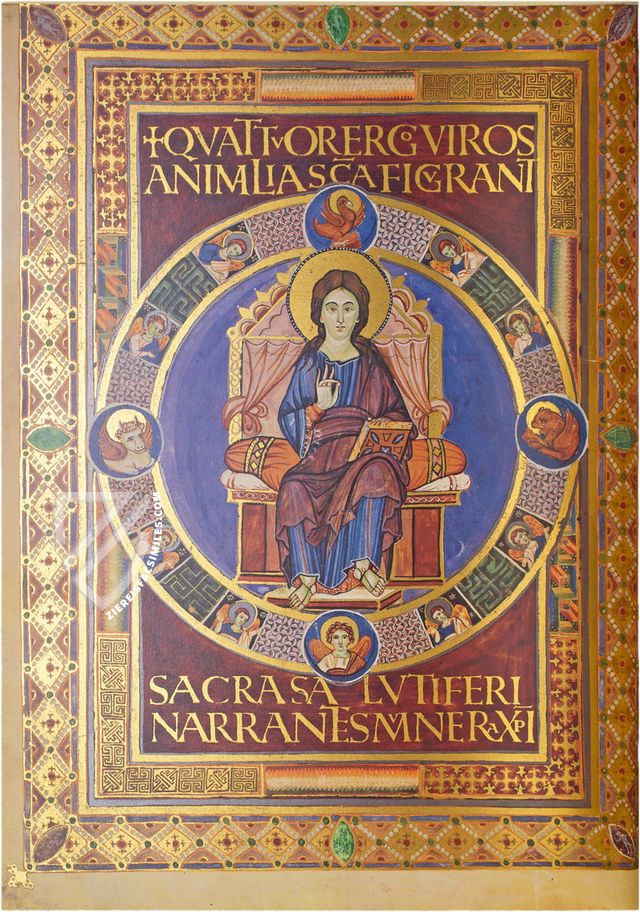
#1 Lorscher Evangeliar (Ivory Binding Edition)
Language: German
(7,000€ - 10,000€)
#2 Lorscher Evangeliar (Library Binding Edition)
Language: German
(3,000€ - 7,000€)
#3 Lorscher Evangeliar
(1,000€ - 3,000€)
- Treatises / Secular Books
- Apocalypses / Beatus
- Astronomy / Astrology
- Bestiaries
- Bibles / Gospels
- Chronicles / History / Law
- Geography / Maps
- Saints' Lives
- Islam / Oriental
- Judaism / Hebrew
- Single Leaf Collections
- Leonardo da Vinci
- Literature / Poetry
- Liturgical Manuscripts
- Medicine / Botany / Alchemy
- Music
- Mythology / Prophecies
- Psalters
- Other Religious Books
- Games / Hunting
- Private Devotion Books
- Other Genres
- Afghanistan
- Armenia
- Austria
- Belgium
- Belize
- Bosnia and Herzegovina
- China
- Colombia
- Costa Rica
- Croatia
- Cyprus
- Czech Republic
- Denmark
- Egypt
- El Salvador
- Ethiopia
- France
- Germany
- Greece
- Guatemala
- Honduras
- Hungary
- India
- Iran
- Iraq
- Israel
- Italy
- Japan
- Jordan
- Kazakhstan
- Kyrgyzstan
- Lebanon
- Liechtenstein
- Luxembourg
- Mexico
- Morocco
- Netherlands
- Palestine
- Panama
- Peru
- Poland
- Portugal
- Romania
- Russia
- Serbia
- Spain
- Sri Lanka
- Sweden
- Switzerland
- Syria
- Tajikistan
- Turkey
- Turkmenistan
- Ukraine
- United Kingdom
- United States
- Uzbekistan
- Vatican City
- A. Oosthoek, van Holkema & Warendorf
- Aboca Museum
- Ajuntament de Valencia
- Akademie Verlag
- Akademische Druck- u. Verlagsanstalt (ADEVA)
- Aldo Ausilio Editore - Bottega d’Erasmo
- Alecto Historical Editions
- Alkuin Verlag
- Almqvist & Wiksell
- Amilcare Pizzi
- Andreas & Andreas Verlagsbuchhandlung
- Archa 90
- Archiv Verlag
- Archivi Edizioni
- Arnold Verlag
- ARS
- Ars Magna
- ArtCodex
- AyN Ediciones
- Azimuth Editions
- Badenia Verlag
- Bärenreiter-Verlag
- Belser Verlag
- Belser Verlag / WK Wertkontor
- Benziger Verlag
- Bernardinum Wydawnictwo
- BiblioGemma
- Biblioteca Apostolica Vaticana (Vaticanstadt, Vaticanstadt)
- Bibliotheca Palatina Faksimile Verlag
- Bibliotheca Rara
- Boydell & Brewer
- Bramante Edizioni
- Bredius Genootschap
- Brepols Publishers
- British Library
- C. Weckesser
- Caixa Catalunya
- Canesi
- CAPSA, Ars Scriptoria
- Caratzas Brothers, Publishers
- Carus Verlag
- Casamassima Libri
- Centrum Cartographie Verlag GmbH
- Chavane Verlag
- Christian Brandstätter Verlag
- Circulo Cientifico
- Club Bibliófilo Versol
- Club du Livre
- CM Editores
- Collegium Graphicum
- Collezione Apocrifa Da Vinci
- Comissão Nacional para as Comemorações dos Descobrimentos Portugueses
- Coron Verlag
- Corvina
- CTHS
- D. S. Brewer
- Damon
- De Agostini/UTET
- De Nederlandsche Boekhandel
- De Schutter
- Deuschle & Stemmle
- Deutscher Verlag für Kunstwissenschaft
- DIAMM
- Droz
- E. Schreiber Graphische Kunstanstalten
- Ediciones Boreal
- Ediciones Grial
- Ediclube
- Edições Inapa
- Edilan
- Editalia
- Edition Deuschle
- Edition Georg Popp
- Edition Leipzig
- Edition Libri Illustri
- Editiones Reales Sitios S. L.
- Éditions de l'Oiseau Lyre
- Editions Medicina Rara
- Editorial Casariego
- Editorial Mintzoa
- Editrice Antenore
- Editrice Velar
- Edizioni Edison
- Egeria, S.L.
- Eikon Editores
- Electa
- Emery Walker Limited
- Enciclopèdia Catalana
- Eos-Verlag
- Ephesus Publishing
- Ernst Battenberg
- Eugrammia Press
- Extraordinary Editions
- Fackelverlag
- Facsimila Art & Edition
- Facsimile Editions Ltd.
- Facsimilia Art & Edition Ebert KG
- Faksimile Verlag
- Feuermann Verlag
- Folger Shakespeare Library
- Franco Cosimo Panini Editore
- Friedrich Wittig Verlag
- Fundación Hullera Vasco-Leonesa
- G. Braziller
- Gabriele Mazzotta Editore
- Gebr. Mann Verlag
- Gesellschaft für graphische Industrie
- Getty Research Institute
- Giovanni Domenico de Rossi
- Giunti Editore
- Graffiti
- Grafica European Center of Fine Arts
- Guido Pressler
- Guillermo Blazquez
- Gustav Kiepenheuer
- H. N. Abrams
- Harrassowitz
- Harvard University Press
- Helikon
- Hendrickson Publishers
- Henning Oppermann
- Herder Verlag
- Hes & De Graaf Publishers
- Hoepli
- Holbein-Verlag
- Houghton Library
- Hugo Schmidt Verlag
- Idion Verlag
- Il Bulino, edizioni d'arte
- ILte
- Imago
- Insel Verlag
- Insel-Verlag Anton Kippenberger
- Instituto de Estudios Altoaragoneses
- Instituto Nacional de Antropología e Historia
- Istituto dell'Enciclopedia Italiana - Treccani
- Istituto Ellenico di Studi Bizantini e Postbizantini
- Istituto Geografico De Agostini
- Istituto Poligrafico e Zecca dello Stato
- Italarte Art Establishments
- Jan Thorbecke Verlag
- Johnson Reprint Corporation
- Josef Stocker
- Josef Stocker-Schmid
- Jugoslavija
- Karl W. Hiersemann
- Kasper Straube
- Kaydeda Ediciones
- Kindler Verlag / Coron Verlag
- Kodansha International Ltd.
- Konrad Kölbl Verlag
- Kurt Wolff Verlag
- La Liberia dello Stato
- La Linea Editrice
- La Meta Editore
- Lambert Schneider
- Landeskreditbank Baden-Württemberg
- Leo S. Olschki
- Les Incunables
- Liber Artis
- Library of Congress
- Libreria Musicale Italiana
- Lichtdruck
- Lito Immagine Editore
- Lumen Artis
- Lund Humphries
- M. Moleiro Editor
- Maison des Sciences de l'homme et de la société de Poitiers
- Manuscriptum
- Martinus Nijhoff
- Maruzen-Yushodo Co. Ltd.
- MASA
- Massada Publishers
- McGraw-Hill
- Metropolitan Museum of Art
- Militos
- Millennium Liber
- Müller & Schindler
- Nahar - Stavit
- Nahar and Steimatzky
- National Library of Wales
- Neri Pozza
- Nova Charta
- Oceanum Verlag
- Odeon
- Orbis Mediaevalis
- Orbis Pictus
- Österreichische Staatsdruckerei
- Oxford University Press
- Pageant Books
- Parzellers Buchverlag
- Patrimonio Ediciones
- Pattloch Verlag
- PIAF
- Pieper Verlag
- Plon-Nourrit et cie
- Poligrafiche Bolis
- Presses Universitaires de Strasbourg
- Prestel Verlag
- Princeton University Press
- Prisma Verlag
- Priuli & Verlucca, editori
- Pro Sport Verlag
- Propyläen Verlag
- Pytheas Books
- Quaternio Verlag Luzern
- Reales Sitios
- Recht-Verlag
- Reichert Verlag
- Reichsdruckerei
- Reprint Verlag
- Riehn & Reusch
- Roberto Vattori Editore
- Rosenkilde and Bagger
- Roxburghe Club
- Salerno Editrice
- Saltellus Press
- Sandoz
- Sarajevo Svjetlost
- Schöck ArtPrint Kft.
- Schulsinger Brothers
- Scolar Press
- Scrinium
- Scripta Maneant
- Scriptorium
- Shazar
- Siloé, arte y bibliofilia
- SISMEL - Edizioni del Galluzzo
- Sociedad Mexicana de Antropología
- Société des Bibliophiles & Iconophiles de Belgique
- Soncin Publishing
- Sorli Ediciones
- Stainer and Bell
- Studer
- Styria Verlag
- Sumptibus Pragopress
- Szegedi Tudomànyegyetem
- Taberna Libraria
- Tarshish Books
- Taschen
- Tempus Libri
- Testimonio Compañía Editorial
- Thames and Hudson
- The Clear Vue Publishing Partnership Limited
- The Facsimile Codex
- The Folio Society
- The Marquess of Normanby
- The Richard III and Yorkist History Trust
- Tip.Le.Co
- TouchArt
- TREC Publishing House
- TRI Publishing Co.
- Trident Editore
- Tuliba Collection
- Typis Regiae Officinae Polygraphicae
- Union Verlag Berlin
- Universidad de Granada
- University of California Press
- University of Chicago Press
- Urs Graf
- Vallecchi
- Van Wijnen
- VCH, Acta Humaniora
- VDI Verlag
- VEB Deutscher Verlag für Musik
- Verlag Anton Pustet / Andreas Verlag
- Verlag Bibliophile Drucke Josef Stocker
- Verlag der Münchner Drucke
- Verlag für Regionalgeschichte
- Verlag Styria
- Vicent Garcia Editores
- W. Turnowski Ltd.
- W. Turnowsky
- Waanders Printers
- Wiener Mechitharisten-Congregation (Wien, Österreich)
- Wissenschaftliche Buchgesellschaft
- Wissenschaftliche Verlagsgesellschaft
- Wydawnictwo Dolnoslaskie
- Xuntanza Editorial
- Zakład Narodowy
- Zollikofer AG

